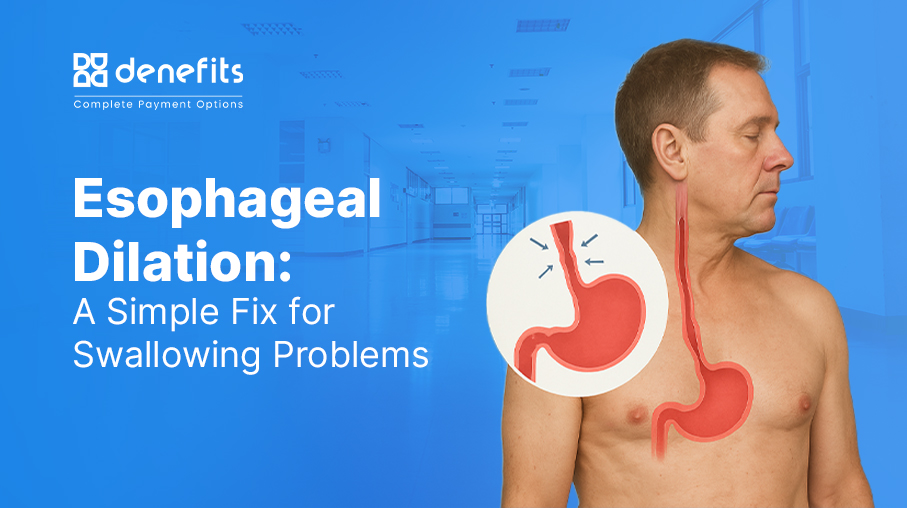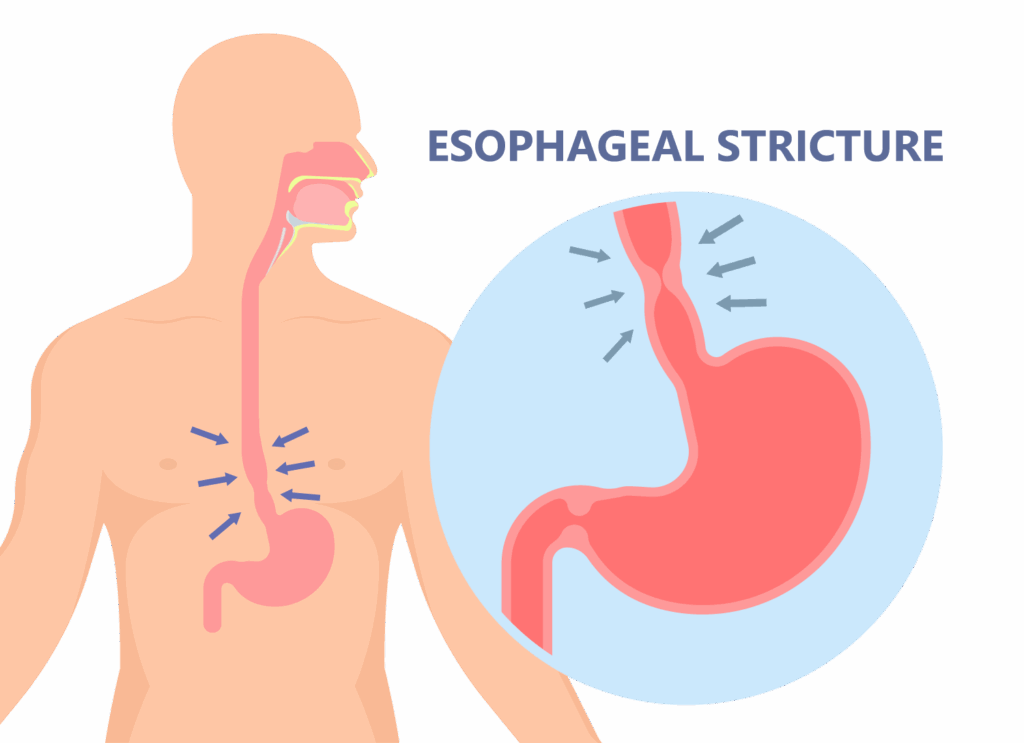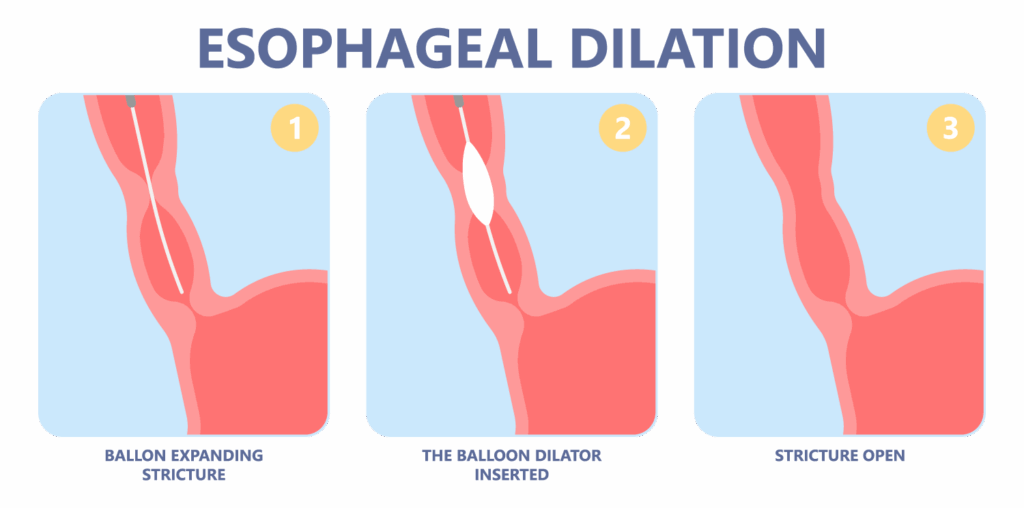
Quick Answer
Esophageal Dilation Meaning
Esophageal dilation is a simple and quick procedure to widen a narrowed food pipe when swallowing becomes hard. A doctor inserts a delicate, thin tube through the mouth and uses either a small balloon or flexible tubes to gently stretch the tight area. It helps food and liquids pass smoothly again. Most people feel better quickly and go home the same day.
Eating and drinking aren’t supposed to be difficult, but sometimes, it slowly starts to change. Food doesn’t go down easily, and even sipping water feels like a task. This usually happens when the food pipe becomes narrow without you realizing it. Over time, this tightness builds up and turns into a regular swallowing issue. That’s where esophageal dilation helps by gently opening up the narrowed area.
It’s a simple outpatient procedure that doesn’t require a hospital stay or long recovery. Most people feel better quickly, while some may need more than one session. This blog walks you through how it works and why it’s often recommended. If swallowing has started to feel different, this might be the solution you need.
Esophageal Dilation
If food feels stuck when you swallow, it might be a stricture. A stricture is a narrow part of your esophagus. It blocks food from going down. This usually happens because of acid reflux, also known as GERD. Over time, acid causes damage that leads to scar tissue and narrowing. And about 80% of strictures are linked to long-term acid reflux problems.
When the passage gets too tight, even drinking water becomes difficult. That’s when esophageal dilation becomes a helpful solution. It’s a simple procedure. It helps your doctor gently stretch the narrowed area. This creates more space so food and liquids can pass smoothly again.
The best part? You don’t need a hospital stay for this. It’s done in an outpatient center. This means you can go home the same day. You’ll be given medicine to help you stay calm during the procedure. Most people feel better quickly, with very little discomfort afterward.
Quick Insights: Sometimes, one session is enough. But a few people may need more. Your doctor will check your healing and guide you through the next steps.
Why Is Esophageal Dilation Needed?
Your food pipe can get narrow due to different reasons. When that happens, swallowing becomes difficult and uncomfortable. That’s when esophageal or esophagus dilation helps.
💠 One Common Reason Is Peptic Stricture.
It usually happens when stomach acid flows back into the food pipe. This acid damages the lining and creates scar tissue over time. That scar tissue tightens the pipe and makes it hard to swallow.
💠 Another Reason Is Something Called Schatzki’s Ring.
It’s a ring of extra tissue where your food pipe meets the stomach. It’s not always painful, but it can block food suddenly. And when that happens, swallowing feels stuck or incomplete.
💠 There’s also a Condition Called Achalasia.
It affects the muscle that connects your food pipe to your stomach. Normally, that muscle opens up when you swallow. But in achalasia, it doesn’t relax, so food doesn’t pass easily. This makes you feel full, uncomfortable, or even in pain while eating.
💠 Then there's Eosinophilic Esophagitis.
It’s caused by an allergy or a trigger that leads to inflammation. The food pipe swells up, and food might get stuck more often. Over time, this swelling can also cause narrowing. Dilation helps in opening that up again.
Note: In some cases, there are other causes, like cancer or radiation treatment. They damage the food pipe and cause the same swallowing issues. And again, dilation is one way to make it better.
Esophageal Dilation Procedure
Esophageal dilation might sound complex, but the process is actually quite simple. Here’s how it happens:
✦ Before Your Procedure
First, your doctor will go through your medical history. If you’ve been sick recently, let them know. Even if it felt minor. Also, tell them about all the medications you take, not just prescriptions. That includes over-the-counter pills, vitamins, and even herbal supplements.
You’ll also need to have an empty stomach before the procedure. Your doctor will give you clear instructions about when to stop eating and drinking. Usually, you’ll need to fast, starting the night before.
This helps avoid complications and keeps the procedure safe. So make sure to follow everything they say without skipping anything.
✦ During the Procedure
This is a short outpatient procedure that usually takes about 15 minutes. You won’t be completely asleep, but you’ll get something to relax. You’ll also get medication to numb your throat and esophagus. This keeps you comfortable while the doctor works.
Once you’re ready, the doctor will insert a thin tube called an endoscope. It goes through your mouth and into your esophagus to help guide the process.
Then, they’ll use stretching the esophagus methods depending on your condition.
🔹One option is balloon dilation.
Here, a deflated balloon is placed where your esophagus is narrow. It’s then filled with air or water to slowly stretch the area.
🔹The other option is bougie dilation.
This method uses thin, flexible tubes that increase in size. They help stretch your esophagus step-by-step if there are multiple tight spots.
After the esophagus is stretched, the tools are removed gently. And you’ll be monitored for a while before you're cleared to leave.
✦ After the Procedure
Most people can go home the same day. You might feel a little sore or have a scratchy throat for a bit. That’s normal and usually goes away soon.
You may need to avoid solid foods for a few hours. It can cause difficulty swallowing after esophageal dilation. Your doctor will let you know when and what you can eat again.
If your esophagus is very narrow, one session might not be enough. In such cases, you may need follow-up treatments to get better results.
Note: If swallowing becomes hard again, don’t ignore it. Tell your doctor right away so they can take care of it. The sooner you act, the easier it is to fix.
Before and After Esophageal Dilation: Graphic Images
- Strictures can cause serious discomfort. They can make swallowing and drinking difficult.

- If there’s a stricture in your esophagus, then esophageal dilation can be the right solution.

Pay for your Treatment with Denefits
Your prompt actions can take away the esophagus discomfort. But it will come at a cost. It can even become more hectic if you’re not insured and have to take a few dilation sessions. That’s why seeking clinics or healthcare professionals who provide flexible payment plans using Denefits is important.
It can help you manage the cost of treatment. Inquire about flexible payment plans during the consultation. Many healthcare providers offer payment flexibility. But you might not get this option everywhere.
The End Note
Swallowing shouldn’t be something you think twice about. But sometimes it turns into that. When it does, it affects more than just meals. It starts to interrupt you every day.
You don’t have to settle into that discomfort or wait for it to pass. Talk to your doctor and get treatment. Also, if you are worried about medical bills, then flexible payment plans with Denefits can take care of that.
FAQs
1. How Long Does Esophagus Stretching Last?
Relief can last months or even longer, but it depends on your condition. Some people need just one session, while others may need repeat treatments.
2. How Many Times Can You Have Esophageal Dilation?
There’s no strict limit. You can have it safely more than once. Your doctor will guide based on how your esophagus responds each time.
3. How Do They Stretch Your Esophagus?
Your doctor uses special tools to gently widen the narrow part inside. They guide the tools with a scope for safety and precision.
4. How to Stretch Your Esophagus at Home?
You can’t safely stretch it at home. Always leave this to your doctor. Trying it yourself could be harmful and make things worse.
5. What Are the Common Steps of Stretching the Esophagus Procedure?
First, you get relaxed and numbed. Then, the scope guides the stretch. A balloon or tube gently widens the tight area during the session.
6. Are There Different Types of Dilations for Stretching Esophagus?
Yes! Balloon dilation inflates the area, and bougie uses flexible tubes. Your doctor picks what’s best based on how tight your esophagus is.
7. What’s Esophageal Dilation Success Rate?
It’s very effective. Most people feel better after just one procedure. Sometimes, a few sessions are needed for long-term comfort and swallowing ease.
8. Is It Possible to Have Chest Pain after Esophageal Dilation?
A little soreness or chest discomfort is normal after the procedure. But if it feels intense or lasts long, call your doctor right away.




